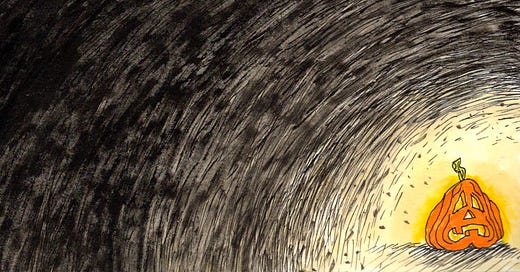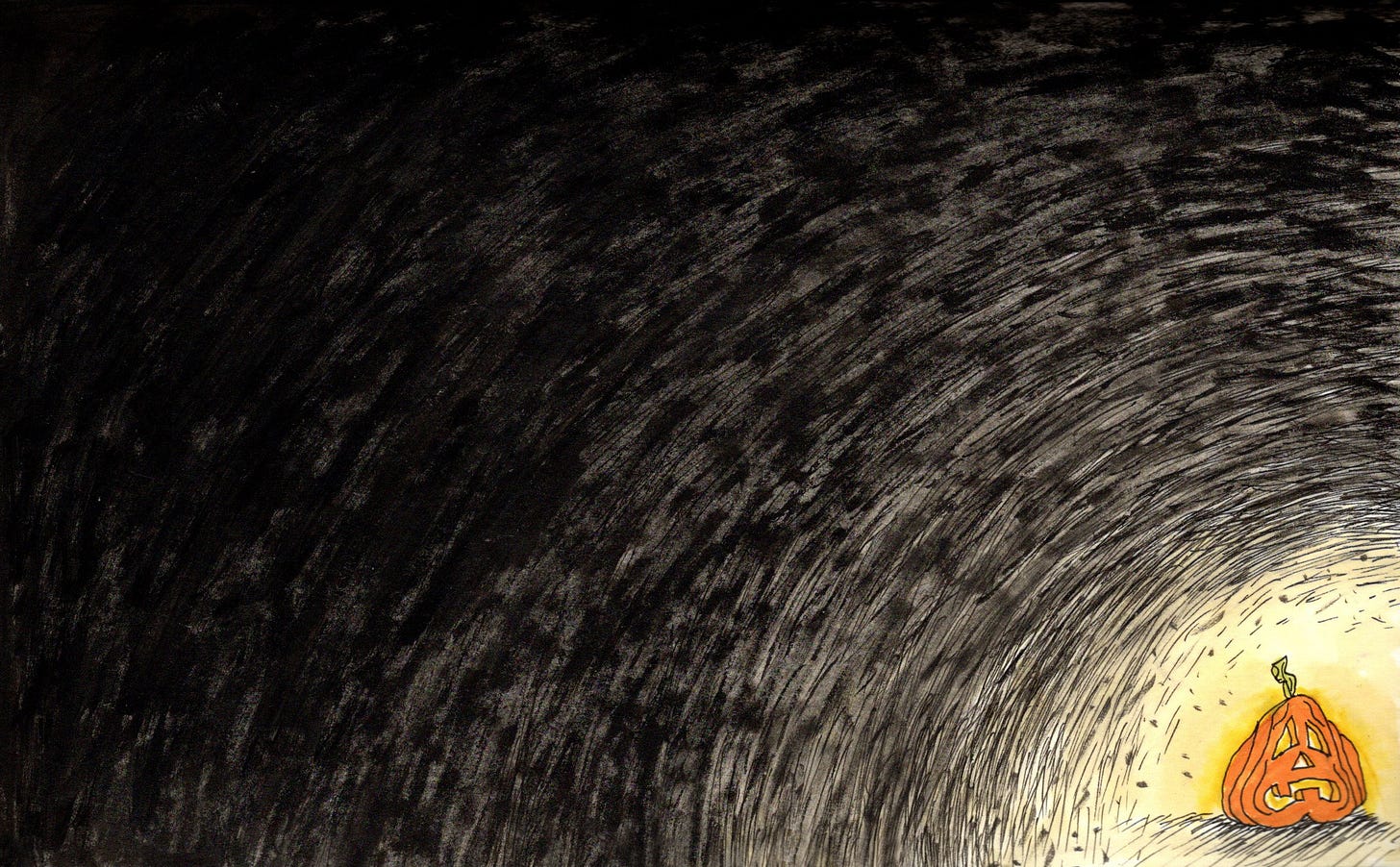Israel recently experienced some of the most horrific mass violence of our lifetimes, which is saying something. Last week’s terrorist attacks were breathtakingly cruel, and there’s no reason to think that the reprisal will prove any softer. I’ve spent a lot of time this week reading and thinking, and I finally figured out what side I’m on: the side of the innocent people, Israeli and Palestinian, who don’t deserve to suffer and die. Whatever the strategies and results, they’re the ones who are going to get the raw end of this, and my heart breaks for them.
In the face of such actual horrors, I’ve found comfort in fake ones. No one comes to me for political insights, and no one should - my little corner of the world has the privilege to linger on art and culture, and, at this time of year, that means Halloween. The decorations have been up since September, but it’s only been this week, following the premiere of The Nerve (and after I can force myself to put away my phone for the night), that the black cats and cobwebs have come out to play.
In honor of spooky season, I’m going to devote the rest of my October posts to Halloweeny themes. Because haunted houses, jack o’lanterns, Draculas, and neon-green witches - these things that were once supposed to be frightening now provide the coziest of comfort. I guess they allow us to rehearse the lineaments of fear in the safety of unreality? And in the days since such stories spawned real-world terrors, their icons have become so defanged (pun HEAVILY intended) that they’ve fallen through the looking glass as negative imprints of the formerly feared unknown. That’s fine by me - I’ve never been one for edge. I’ll take them over bombs and murder any day, cold comfort though that might be.
As for my regular roundup, there’s plenty to catch up on after last week’s sabbatical…
(A question before we get into all this - would it be interesting/valuable to anyone who reads this far to share images from the books and movies discussed? Links to Goodreads or Letterboxd? Just wondering if that would give y’all more color and flavor for these posts…)
BOOKS FINISHED
The Odd Woman and the City: A Memoir, by Vivian Gornick: I’ve read essays by Gornick, and encountered her name in respectful tones over the years, but I never thought to pick up a book from her until I’d heard about this strange little volume. A lifelong NYC dweller (born in the Bronx, spent most of her adulthood in Manhattan), she looks back at her life from the vantage of her 80s, a twice-married, childless loner who prefers the bustling anonymity of the city to the inconvenience of intimacy. She tells her story in fragments, interspersed with caustic vignettes that depict the comedies of contingency that unite urban strangers in unlikely circumstances. Her hard-won observations are brought to life in prose whose beauty competes with its sharpness - I was particularly taken with her insights on the fraught necessities of friendship, which both soothe and exacerbate the challenges of city living. I’ll definitely be seeing her work out more regularly.
The Best of Impossible Worlds, by Abel Quezada: This is a collection of translated newspaper strips from one of Mexico’s most popular mid-century cartoonists. What I love about it is the way that the stories unfold in a combination of drawings and handwritten prose - more like illustrated essays than traditional comics. Topics range from Cold War allegories to spoofs on Hollywood fantasy. Nothing earthshaking, but a very charming read.
Escape from Suburbia, by Caza: This one-named French cartoonist’s opus Kris Kool is the epitome of psychedelic-era European comics; this collection of short stories from a couple of decades later has a completely different visual style, but still chafes against the established order of things, albeit in a bit more on-the-nose way. While the “suburbs” of late 20th-century Paris aren’t quite the same as the American stereotypes, they both embody a stultifying conformity and passivity, which Caza rails against with every stroke of his pen. The sentiments are familiar to any teenager who longs to move out of their hometown, infused with a middle-aged sourness; the art, though, is superb.
The Skull, by Jon Klassen: This is an enjoyable early-reader retelling of an old folk tale about a little girl who befriends a skull in an abandoned mansion in the woods. No new ground broken, but Klassen’s art, which is somehow sprightly and moody at the same time, made me chuckle out loud a few times.
Pure Color, by Sheila Heti: Wow, did I have mixed feelings about this one. I’d never read Heti’s work before, and this novel from last year was a very odd place to start. It reads like an allegory or parable about a young woman who doesn’t seem to do much in her life other than mourn her father and harbor regrets about a doomed love affair. Everything that happens seems to be viewed through a thick pane of glass, where you can make out movements but not features. At one point the heroine turns into a life for about 50 pages. I often felt like throwing the book across the room, but then I’d read an exhilarating turn of phrase, or struck fresh by the audacity of telling a story that denies you the satisfactions of storytelling while still somehow remaining compelling. Still chewing on it, to be honest.
The Structure Is Rotten, Comrade, by Viken Berberian and Yann Kebbi: To start off, the art in this graphic novel is an absolute treat - loose and sketchy, but bursting with color and humor; slapstick Bauhaus by way of Saul Steinberg. The story, which follows a young French-Armenian architect whose passion for destructive construction makes him the object of an armed revolt, has interesting things to say about politics and urbanism, without being heavy-handed about it. There are some odd choices that don’t entirely work, but overall it was unique and enjoyable.
The Storyteller Essays, by Walter Benjamin: I’ve always been intimidated by the work of Benjamin, and unfortunately, I don’t think this was the best place to start. I had a copy of his Illuminations for years but got rid of it before cracking it open. I’ve always wanted to read one of his most famous essays, “The Storyteller,” which deals with the transition from the communal tradition of oral/epic storytelling to the more insular and subjective form of the novel. When this slim collection of Benjamin’s writings related to that piece came to my attention, I thought it would make a good start. The main essay was very interesting, but I think my experience of it was clouded rather than illuminated by the ancillary material - maybe it’s time to try Illuminations again.
20 km/h, by Woshibai: A collection of gnomic, wordless comics by an up-and-coming young Chinese cartoonist. Serene and universal, they didn’t show me much I’d never seen before in other forms, but it was still pleasant bedtime reading.
BOOKS STARTED
A Foot in the Grave, by Joan Aiken and Jan Pienkowski
Masterpieces of Terror and the Supernatural, ed. Marvin Kaye:
MOVIES WATCHED
Sh! The Octopus (1937, dir. William C. McGann): Other than boasting one of the best movie titles of all time, this happens to be the perfect rainy-afternoon romp for October. Two bumbling cops get called to a lighthouse on stormy seas to investigate a murder, where they run afoul of either A) a crime boss known as The Octopus, B) an actual living, breathing giant octopus, or C) some very confusing combination of the two. No matter what, rest assured that you will see some of the most delightful and peculiar visual SFX of the 1930s! It is less than an hour long, and it is streaming on YouTube, and you really have no excuse not to watch it this weekend. (Hat tip to my good friend Trav S.D. - while this film had been on my radar before, he brought it to the top of my queue with his recent roundup of his top eight octopus-themed films in honor of World Octopus Day!)
More Halloween to come!





